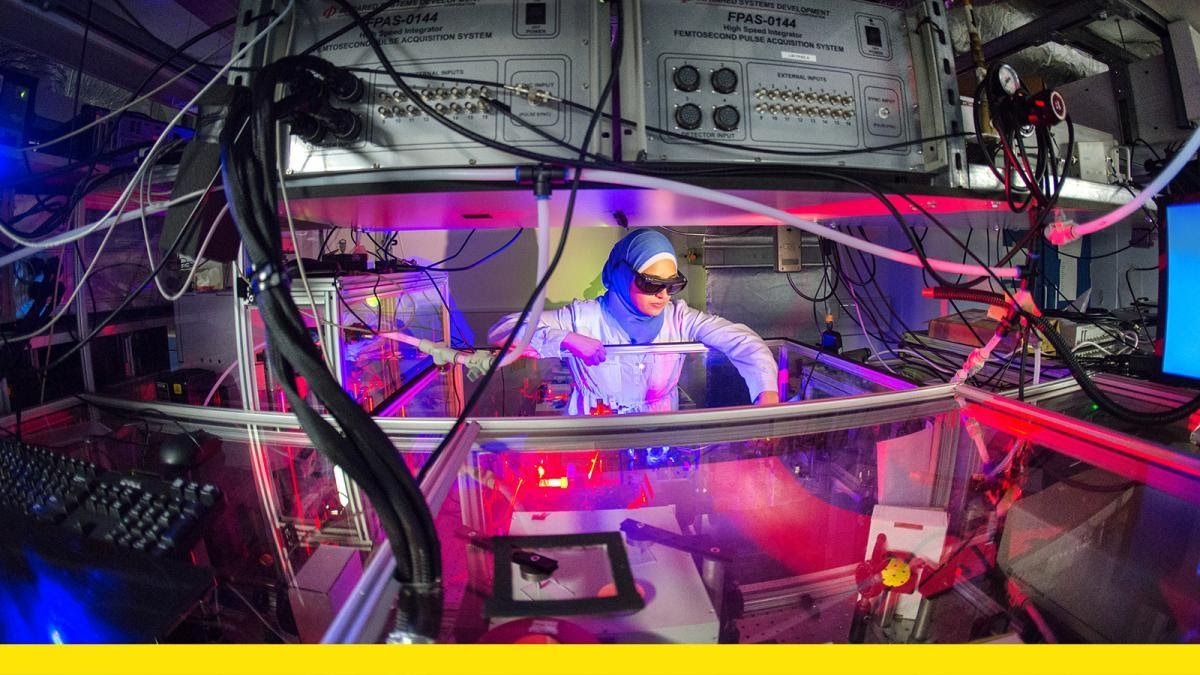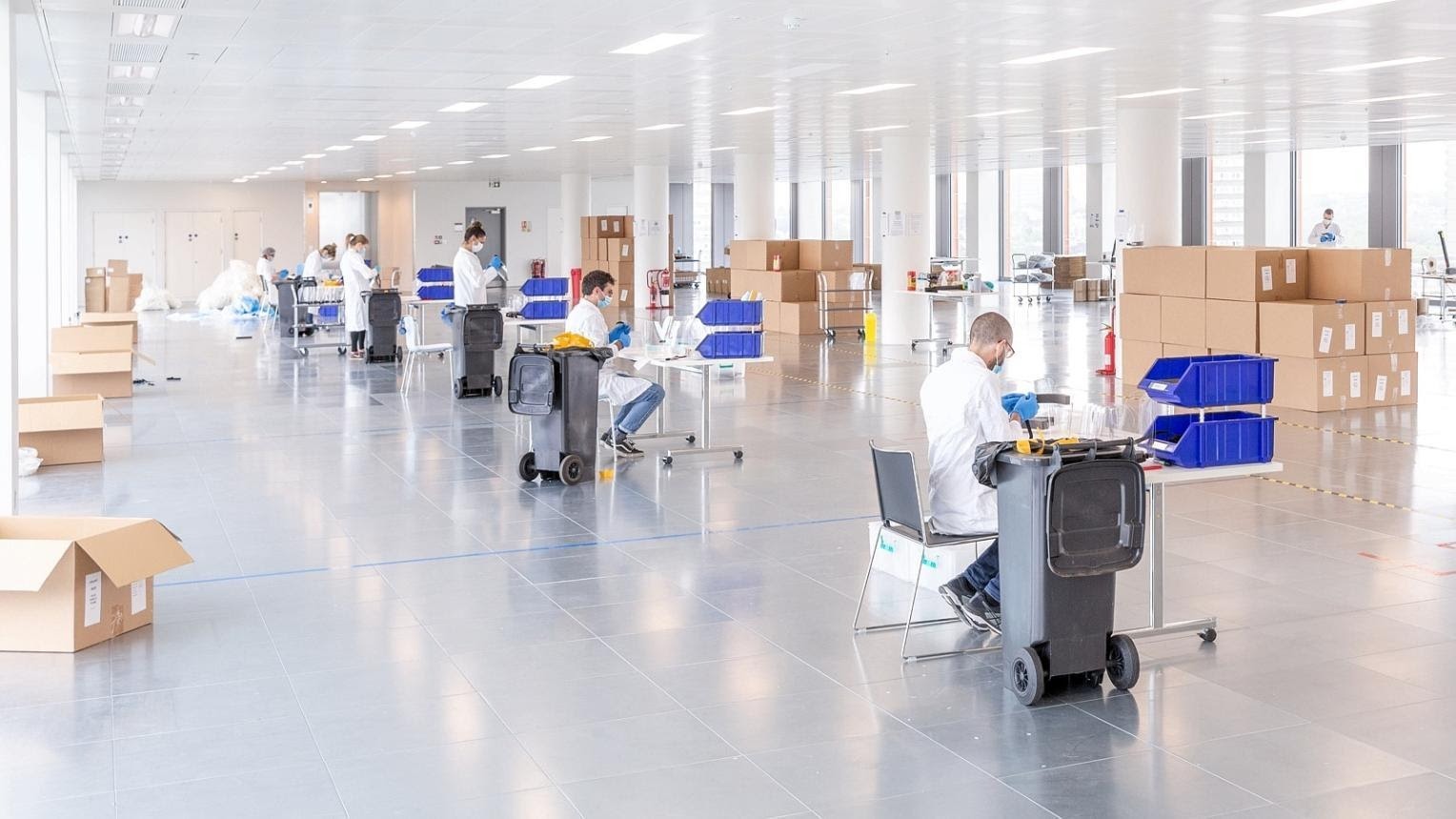Why Imperial College London is the University of the Year 2022
As Imperial College London epidemiologists were telling an anxious nation what to expect next in the pandemic, its staff and students were coming up with a pandemic learning experience that actually worked.

Imperial leads the way using ultrafast molecular imaging techniques at its Thor lab
This year’s Good University Guide captures the unique challenges that campuses have faced with Covid-19, reflected in the shake-up in our rankings of more than 130 British universities. Our analysis also identifies the institution where students felt most engaged with their reimagined educational path: Imperial College London.
Ranked fourth in our overall academic table, this specialist in science, engineering, medicine and business has gained 80 points in our rankings in the past year, closing on Cambridge, Oxford and St Andrews above it. Imperial also ranks seventh in the latest QS World University Rankings.
In a year when the pandemic left students stranded, often far from campus, Imperial made sure its international community of 10,500 undergraduates and 9,000 postgraduate students did not feel displaced from its academic heart in central London. In recognition of Imperial’s achievements in lockdown it is not only our University of the Year but also our University of the Year for Student Experience.
If Oxford — last year’s University of the Year — has led the way out of the pandemic through vaccine development, Imperial has been the university to tell us where the pandemic was going next. Its epidemiologists, professors Neil Ferguson and Azra Ghani, became the face of the science that the government and the public were exhorted to follow from one pandemic development to the next. They quickly became familiar figures in the corridors of power as well as on TV and radio.
“I would hope our students would be proud to be associated with all the work we have been doing on the Covid response,” said Professor Emma McCoy, Imperial’s vice-provost for education and student experience.
As most students vacated the campus to go home, McCoy led a team that met daily to plan Imperial’s response and keep the lights on academically. “The opportunity to solve a new problem actually sparked some amazing resources that we can take forward into next year and future years,” she said. “We have used our scientific approach to find the best way to deliver our education.”
Students were at the heart of the decision-making as well as being the beneficiaries. “We have brilliant students, so it would be foolish not to make the most of that. A lot of the decisions we have made have been informed by the students’ understanding of what they need. I’ve often felt I have learnt more from students than I have from many of my [academic] collaborators.
“There has been a culture shift in terms of the university being a community of scholars, rather than this hierarchical structure of academic staff and students. We want to work together as a community where we are all out to solve the big problems.”
The roots of this “culture shift” can be traced back to 2016, when the late Professor James Stirling, then provost of Imperial, acknowledged that the university needed “to understand where we have fallen short in the experience we offer to students.
“We need a fresh approach to respond to student feedback,” he said in a stark assessment after a particularly lacklustre set of results in the National Student Survey (NSS), which left the university 124th in the UK for student satisfaction with teaching quality and 77th= for satisfaction with the wider student experience.
Five years later, the turnaround is impressive. Imperial is one of just two universities to make a net gain — and comfortably the biggest one — in our analysis comparing NSS outcomes in 2020 and 2021. It now ranks third for satisfaction with the wider student experience and 28th= for satisfaction with teaching quality.
Where some universities — often members of the highly-selective Russell Group — have appeared powerless to address consistently poor NSS ratings over the years, Imperial was determined to tackle the issue and is now willing to share the secrets of its success. “As a nation, we want to see all universities improve what they are doing,” said McCoy, who admitted that she had awaited this year’s NSS results with trepidation, given Imperial’s previous form.
She believes that clear communication with students and between staff was vital to keep students on board as they grappled with remote learning and assessment formats. “We shared good practice very quickly and provided guidance on how people could deliver education remotely. We have some amazingly innovative teachers.”
Investment has accompanied innovation: Imperial has spent more than £7 million on teaching spaces in the past year. The student support fund was beefed up, with extra resources made available for laptops for those struggling with remote learning due to poor equipment. Imperial ranks second this year for the amount of money per student spent on services and facilities.
Rent waivers were issued promptly when student accommodation was closed during the pandemic and students who found themselves self-isolating had their meals delivered and laundry done for them. There were regular check-ins and social events such as exercise classes were streamed online.
Final-year students gave their verdict accordingly — adding up to gains for Imperial in a remarkable eight out of nine areas in the NSS. The overall effect of the pandemic has been to align the university’s student satisfaction scores with its competitive performance in many other measures that contribute to our rankings.
Imperial’s graduates already earn more than those from any other institution, with a median salary of £33,500 within 15 months of finishing their course, rising as high as £50,000 for its computer science graduates. The university is second only to St George’s, University of London for the proportion of graduates — 92 per cent — in high-skilled employment or postgraduate study within 15 months of leaving.

Imperial volunteers produce disposable visors for frontline staff at Imperial College NHS Trust hospitals during the coronavirus crisis
St Andrews, twice the winner of our University of the Year title, tops our overall academic table for the first time. It is also the first time Cambridge or Oxford have been knocked off the top spot.
This momentous achievement has been a long time in the making, as the Scottish institution steadily chipped away at the Oxbridge old guard. Its students have repeatedly conveyed their greater satisfaction with their university experience to pollsters at Ipsos Mori, which administers the NSS.
This year St Andrews is in first place in both of our measures derived from the NSS — for satisfaction with teaching quality and the wider student experience — and is about four percentage points clear of the universities in second place on each, a statistically vast amount in a survey where scores tend to be very compressed.
Warwick, our runner-up for University of the Year, is another institution that embraced the academic and research challenges presented by the pandemic. Academics from its School of Life Sciences and Mathematics are members of the Scientific Pandemic Influenza Group on Modelling, which provided the Scientific Advisory Group for Emergencies with models on the spread of the coronavirus.
From an undergraduate perspective, Warwick students strongly endorsed its pandemic model, lifting the university into the top 20 on both our measures of student satisfaction. Warwick pledged to continue to “actively engage our students in the co-creation of new ways of learning”. Like Imperial, it attributed some of its success to clear and consistent communication with students.
Above all else, levels of engagement and communication with students set our winners apart at a time when the pandemic made both much harder. Applicants considering their five Ucas options this autumn would do well to take note.
University of the Year
Runner-up
Shortlisted
Edge Hill University
Ulster University
University of York
Modern University of the Year
Scottish University of the Year
Welsh University of the Year
Sports University of the Year
University of the Year for Social Inclusion
University of the Year for Teaching Quality
University of the Year for Student Experience
University of the Year for Graduate Employment
University of the Year for Student Retention